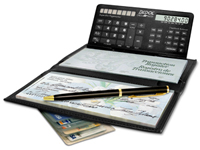Checkbook Memory
Does your checkbook have a memory? The answer is a partial yes. It's a What's Left document. You record deposits in your checkbook, you record expenditures, and you keep a running balance of the cash that remains. You do not keep running totals of the types of money you received (such as net payroll, loans from others, repayments of loans you made previously, et al) or how you spent your money by category.
that remains. You do not keep running totals of the types of money you received (such as net payroll, loans from others, repayments of loans you made previously, et al) or how you spent your money by category. If you want a report of summary activity by category you have to use an adding machine and make lists of the totals you spent for clothes, transportation and so on.
One reason that personal money management computer programs, such as Quicken, are so popular is that they do keep running totals of how you receive and spend your money.
Whatís Happened and Whatís Left Accounting is the process of keeping a history of money movement. Accounting applies to the financial activities of a person, a company, a non-profit organization, or any other entity.
You need accounting to answer two basic questions, what happened and what's left? The emphasis is on the word history; accounting does not attempt to predict the future, although you can use accounting to compare actual results to prior predictions.
Budgets can be used to compare dreams with reality as the reality is happening.
However, if you don't record a transaction you cannot account for it.
Well designed and maintained accounting systems tell you what happened in the money soup and what's left at the end of the year, or any other period you choose.
Here is an illustration.
You start a Widget Selling business, and set up three account classifications, CASH, SALES, and EXPENSES. During your first month of operations, you sell 100 widgets at $100 each, a total of $10,000. The cost of each widget you sell is $65, a total of $6,500.
At the end of the month your classifications accounts show SALES = $10,000, EXPENSES =$6,500, and CASH= $3,500. The SALES and EXPENSES accounts are "What Happened" accounts since you classify sales and expenses as running total accounts.
The CASH account is a "What's Left" account since you classify the receipts from sales ($10,000) as additions to the CASH account, expenses related to sales ($6,500) as subtractions, and the CASH remaining is $3,500, the difference between $10,000 and $6,500.
Why Double Entry Accounting?
How do you keep track of your financial status at a specific date- AND your profits and losses over a period of time and use the same accounting database?The question is solved by storing all of your financial and business transactions in a single database, and using certain categories as What's Left pigeon holes, and other categories as What Happened pigeon holes. For example, you have an account called Cash - East Bank of Mississippi. You want to know at any point in time how much money you have. So the transactions posted to this account include both deposits (Plus transactions) and withdrawals (Minus transactions). If you keep running totals of the plus transactions, running totals of the minus transactions, and calculate the difference at any point in time you have the Balance. Thus Cash is a Balance sheet account.
The answer lies in the term "double-entry". In a double-entry system, each transaction is tracked to a Balance Sheet or What's Left pigeon hole AND/OR an Income or Expense or What Happened pigeon hole.
The data in all the pigeon holes are mixed together in one database. This is the Money Soup.
The Secret of Double Entry Accounting
In Double Entry Accounting Everything Adds Up to Zero!Any accounting transaction in a double entry accounting system has both a plus and a minus side. In this context plus and minus are not value judgments, they are only arithmetic signs.
The first test of any accounting transaction or group of transactions is to see if the totals add up to zero. The sum-zero test is the first test that an auditor uses to see if the accounting records are being well maintained.
Types of Accounting Diaries
You could record each accounting transaction is a single diary of transactions, also known as an accounting journal, but you seek different information from your accounting journals depending on the type of transaction. So we use different journals. Some examples are:Sales (for cash or customer credit terms)
Purchases (paid by cash or on vendor credit terms)
Cash received (a sale for cash, receipt of an amount due from a previous sale, borrowing money)
Cash spent ( an expense, or a payment to a vendor)
Payroll (details of payroll including income taxes withheld)
Adjustments Other special entries, sometimes used to correct previous transactions recorded in error.
This is not an exhaustive list. Any chronological record of accounting transactions can be a journal. For instance, a customer order entry journal, an inventory receiving journal, and so on.
Accrual or Cash Accounting?
 Why do you care? Because the measurement of net profit is different depending on which method you use.
Why do you care? Because the measurement of net profit is different depending on which method you use. If you are using the cash basis you do not record a transaction until money has been deposited in the bank, or paid out of the bank. On an individual basis, most of us report our income taxes using this method. If you are using the accrual basis, you record income when you make a sale on credit (before you have been paid), and you record an expense when you have incurred an obligation (before you have paid your creditor). Accrual basis accounting is generally more useful in managing a business.
Go to Cash or Accrual Example to see how this can work.
Cash or Accrual Example
In the first year Henry's Widget Consulting Business has credit sales of $3,500,000 in 2001. In the same year he has $2,900,000 of expenses, therefore a net profit of $600,000. At the end of the year his customers owe the business $300,000 and he owes his vendors $150,000.What business taxes are due, assuming a business income tax rate of 40% ? If you use the accrual method and your profit is $600,000 the business income taxes are $240,000.
However, you can use the cash basis for measuring profits in filing tax returns under certain circumstances . In this case, your cash sales are $3,200,000 (based on collected sales) and your cash expenses are $2,750,000 (based on actual expenses paid). There for your taxable income is $450,000 and your business income taxes are $180,000, a difference of $60,000.
The good news is that for many businesses, you can manage your business using accounting information supplied on an accrual basis but report your business income taxes using a cash basis